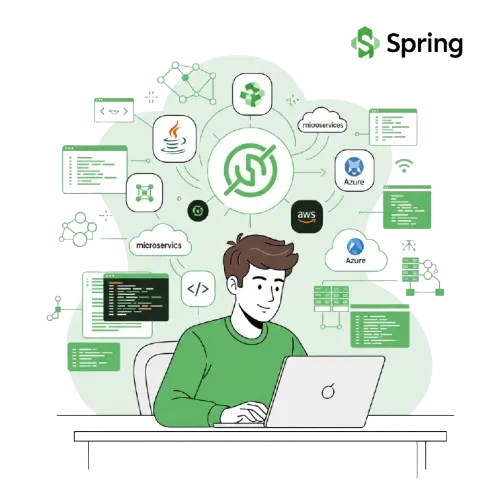SPRING-tutorial
This comprehensive Spring tutorial is designed for both beginners and experienced developers. Spring is one of the most widely used Java frameworks for building scalable, maintainable, and high-performance applications.
Our mission is to make learning simple, practical, and structured. This tutorial will take you from the fundamentals of Spring to advanced concepts, with real-world use cases and hands-on practice. By the end of this journey, you'll be confident in developing Spring-based applications.
Why Learn Spring ?
Spring is an industry-standard framework used by top tech companies and widely adopted in enterprise-level Java development. Here’s why it’s worth learning:


1. High Industry Demand – Used by companies like Google, Microsoft, and Amazon for backend services.
2. Modular and Scalable – Offers a flexible architecture that supports modular development and easy scalability.
3. Boosts Productivity – Features like Dependency Injection (DI) and Aspect-Oriented Programming (AOP) help write clean, maintainable code.
4. Perfect for Microservices and Cloud – Spring Boot enables rapid development of microservices, ideal for cloud platforms like AWS and Azure.
What You Will Learn in This Tutorial
This tutorial covers the entire Spring ecosystem, starting from core concepts to advanced modules:
1. Introduction to Spring
- What is Spring?
- Key features and benefits
- Spring architecture overview
2. Spring Core
- Dependency Injection (DI)
Autowiring
- Factory Method
3. Spring MVC
- Introduction to Spring MVC
- Handling multiple controllers
- Spring MVC applications (CRUD operations)
4. Spring Java Mail
- Overview of JavaMail integration
5. AOP (Aspect-Oriented Programming)
- What is AOP?
- AOP in action: Examples, Advice types, Join Points, and Weaving concepts
Learning Approach at Quipoin
Our tutorial is structured to maximize both understanding and retention:
1. Key Points:
Each chapter highlights the most important concepts to focus your learning.
Each chapter highlights the most important concepts to focus your learning.
2. Syntax and Examples:
We include simplified syntax and real-world examples to ensure you grasp the practical use of each concept.
We include simplified syntax and real-world examples to ensure you grasp the practical use of each concept.
3. Hands-On Exercises:
Apply what you have learned with coding tasks in each chapter.
Apply what you have learned with coding tasks in each chapter.
4. Interview Preparation:
Every chapter includes frequently asked interview questions to help you get job-ready.
Every chapter includes frequently asked interview questions to help you get job-ready.
Tips for Effective Learning
- Start with the basics, then move to advanced topics.
- Don't just read write and run the code in your IDE (Eclipse or IntelliJ IDEA recommended).
- Join tech forum MindXchange to connect with the community.
- Apply your knowledge by building a Spring-based application from scratch.
This tutorial is designed for learners aiming to start or advance their backend development career with Spring. By following along and practicing consistently, you will gain the skills needed to build robust, enterprise-level Java applications with confidence.